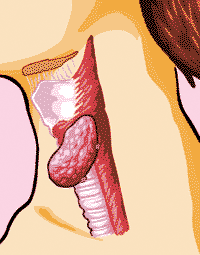| Home A B C D E F G H I J K L M N O P Q R S T U V W X Y Z |
|
Home |
The Function of the Thyroid GlandYour Thyroid: What it is and What it doesYour thyroid is a butterfly-shaped gland in the lower, front part of your neck. It controls your metabolism and keeps your whole body functioning properly. Get the basics (and specifics) here. 
Before I was diagnosed with hypothyroidism, I didn’t really know or honestly care much about what my thyroid was. I sure didn’t know how it functioned. After the diagnosis, those feelings changed. The thyroid is a little gland. A gland is a structure that makes hormones. (We’ll get to hormones in a little bit.) The thyroid only weighs about one ounce. It’s very light and appears larger in men than in women. It looks like a butterfly or bowtie, depending upon whom you ask. Where is the thyroid located? The thyroid is located in the lower, front part of the neck, near the trachea, or windpipe. The isthmus, which is part of the thyroid gland, is the band of tissue that connects those wings. What does the thyroid do? The thyroid’s main job is to produce thyroid hormone. Hormones are chemicals that are secreted by glands which act like messengers telling specific body parts what to do. Thyroid hormones help the body make energy, keep body temperature regulated and assist other organs in their function. The thyroid produces two major hormones: triiodothyronine and thyroxine, commonly referred to as T3 and T4. (The “3” and the “4” relate directly to the amount of iodine molecules which are used to create these hormones.) How does the thyroid create T3 and T4? In order to understand this question, it’s important to note that thyroid cells are the ONLY cells in the body which are able to absorb iodine. Iodine is a vital trace mineral which is found in food. Iodine is an integral component in the creation of thyroid hormone and, thus, the metabolism. The metabolism refers to the way the body turns food into energy. It’s elemental to our lives. Iodine combines with tyrosine, an amino acid. There are over 20 amino acids in the body. They are the building blocks of cells. Therefore, tyrosine and three iodine molecules combine to make triiodothyronine, or T3. Tyrosine joins with four iodine molecules to make T4, thyroxine. A healthy thyroid produces about 80% of T4 to 20% of T3. If more T3 is needed, some inactive T4 hormone will go through a process called mono-deiodination, or T4 to T3 conversion. One of the iodine molecules is released to complete this transformation. People with hypothyroidism do not produce enough thyroid hormone to maintain proper metabolic functioning. Article by Deanna Couras Goodson.
|
|||
|
|
|||
|
Glossary References Links Contact
|